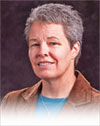
The calving seasons could get long rather abruptly due to disease outbreak or bull infertility or gradually get longer and longer over several years. Sometimes heifer development or young cow nutrition shortfalls create the problem.
Whatever the cause, long calving seasons reduce weaning weights and increase variation in those weights. To determine the best route back to a tighter calving season, it helps to review the influence of days postpartum and body condition on when cows might be expected to begin cycling again after calving.
In a 60-day breeding season, a cow that was bred on the last day of this year’s breeding season will only be 22 days postpartum at the start of the next year’s breeding season. In contrast, a cow bred on the first day of this year’s breeding season will be 82 days postpartum at the start of next year’s breeding season.

Data from over 3,000 Kansas cows (see Figure 1) predicts that approximately 70 percent of cows that are 81 to 90 days postpartum would be cycling at the beginning of the breeding season and less than 10 percent would be cycling when less than 30 days postpartum. If a 90-day breeding season is allowed, then the last cow to be bred is just one week from calving at the start of next year’s breeding season. If she is in good condition this cow may have one and possibly two opportunities to conceive before the end of a 90-day breeding season.
Body condition also affects the proportion of cows cycling at the beginning of the breeding season (see Figure 2). In this summary, the proportion of cows cycling increased 18 percent for each unit increase in body condition score.
Given information on calving distribution and body condition score, it is possible to project the next year’s calving distribution. When you are interested in shortening a calving season, this can be useful to see how many cows might be impacted by removing bulls at various times.

Two key concerns associated with late calving are how many days cows are eating an expensive lactation diet before actually lactating and how much lighter calves are at weaning as a result of age. Table 1 illustrates those differences for a range of calving season lengths. Producers must ask themselves if the dollars spent on feed for late-calving cows wouldn’t be better spent on cows that would produce heavier calves at weaning.
If identified in a timely manner, late-calving cows could be marketed in a bred cow sale. If pregnancy diagnosis is used to identify cows that would have been open in a defined breeding season, then staging pregnancies is much more precise for pregnancies less than 120 days. Another approach to reducing a long calving season is to reduce the length of bull exposure by about one week per year.
Several methods could be used to induce late-calving cows to cycle if they are at least 30 days since calving and are on an increasing plane of nutrition.
Success of any of these methods will increase with cow body condition and days since calving. Methods used to synchronize estrus that include progesterone such as the CIDR (controlled internal drug release; intravaginal insert containing progesterone) can be used on late-calving cows to induce them to cycle. Insert the CIDR for seven days, remove and place cows with bulls. Calf removal for 48 hours could be used alone or combined with the CIDR. Start calf removal at the end of CIDR treatment.
Bull exposure will also shorten the postpartum interval to estrus but the response is better when cows are at least 40 days postpartum when first exposed to bulls. Generally, bull exposure has no effect on estrous cyclicity when cows have been exposed continuously to bulls since calving.
Managing cows to maintain adequate body condition is much easier when the range of nutrient requirements of the cows is narrower. A long calving season not only becomes tiresome because of the extra attention required at calving, but ends up using more feed resources (or multiple management groups) and reduces calf weaning weights. Late-calving cows become like a slow leak – they don’t necessarily cause you to go under but they can be a drain on profitability. ![]()
This article originally appeared in the KSU Research and Extension newsletter.

Sandy Johnson
Livestock Specialist
Kansas State University Research and Extension
sandyj@ksu.edu








